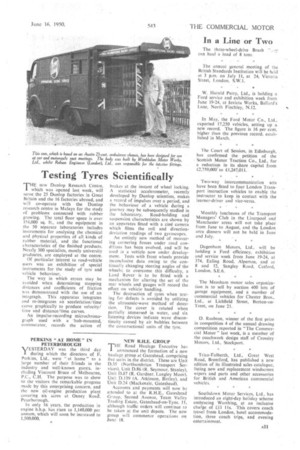Testing Tyres Scientifically
Page 33

If you've noticed an error in this article please click here to report it so we can fix it.
THE new Dunlop Research Centre, which was opened last week, will serve the 25 Dunlop factories in Great Britain and the 16 factories abroad, and will co-operate with the Dunlop research centre in Malaya for the study of problems connected with rubber growing. The total floor space is over 154,000 sq. ft., and the equipment in the 50 separate laboratories includes instruments for analysing the chemical and physical properties of all kinds of rubber material, and the functional characteristics of the finished products. Nearly 300 specialists, mostly university graduates, are employed at the centre.
Of particular interest to road-vehicle users was an exhibition of special instruments for the study of tyre and vehicle behaviour.
The way in which errors may be avoided when determining stopping distances and coefficients of friction was demonstrated with the use of an integraph. This apparatus integrates and re-integrates an acceletation/time curve. graphically to produce velocity/ time and distance/time .curves.
An impulse-recording microchronograph used with a -hub-mounted, commutator, records the action of
brakes at the instant of wheel locking. A statistical accelerometer, recently developed by Dunlop scientists, makes a record of impulses over a period, and the behaviour of a vehicle during a journey may be subsequently studied in the laboratory. Road-holding and suspension characteristics are shown by an apparatus fitted with a eine camera which films the roll and directiondeviation readings of two gyroscopes.
An entirely new method of measuring cornering forces under road conditions has been evolved, and will he used in a vehicle now under development. Tests with front wheels provide inconclusive data owing to the continually changing steering angles of the wheels; to overcome this difficulty, a Land Rover is to be fitted with a mechanism for altering the set of the rear wheels and. gauges will record the effect on vehicle handling.
The destruction of tyres when testing for defects is avoided by utilizing the ultrasonic-wave method of detection. The cover is rotated when partially immersed in water, and six listening devices indicate wave discontinuity caused by air bubbles between the constructional units of the tyre.












































































